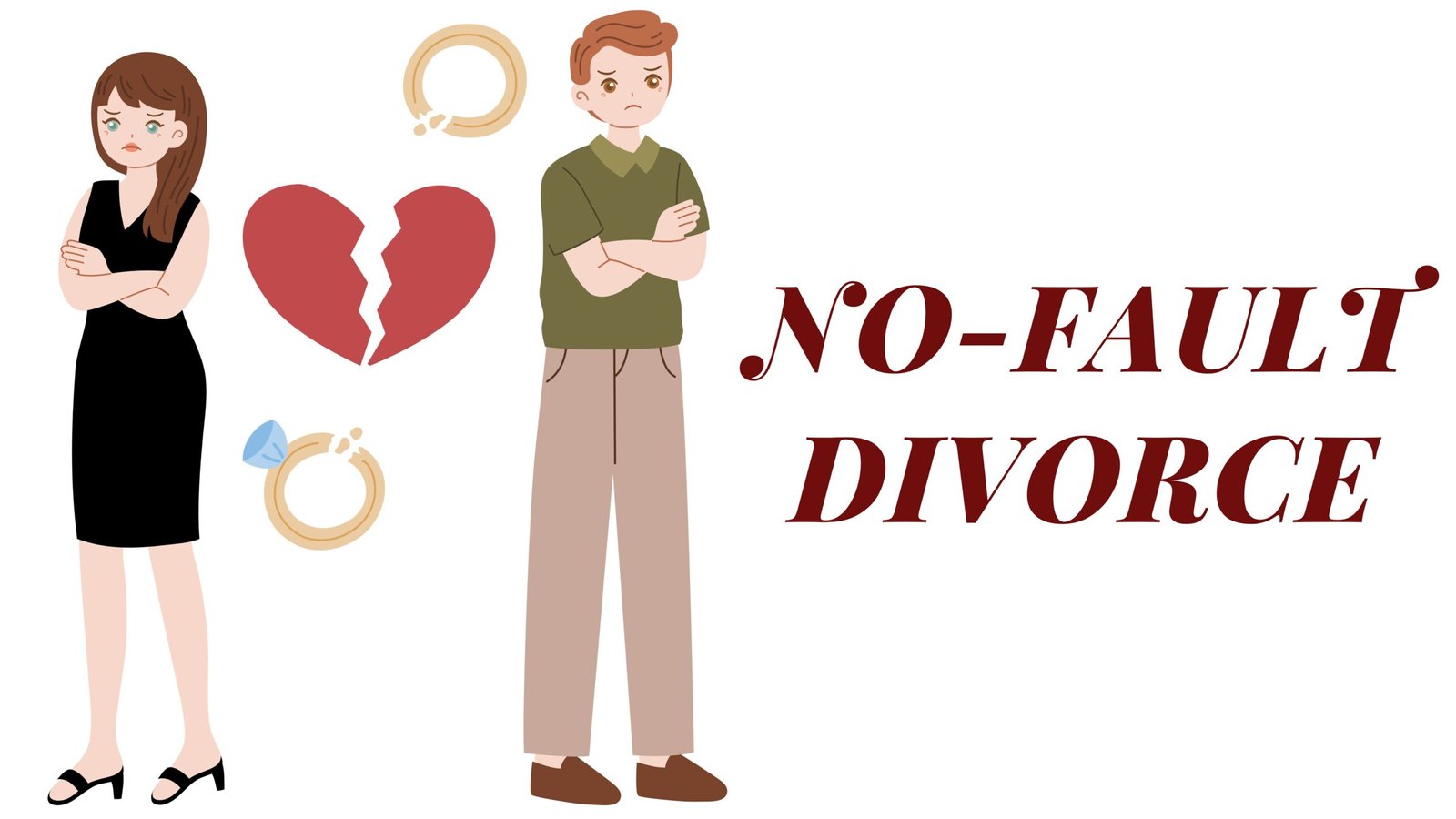On this page you will read detailed information about “No-Fault Divorce”.
As you navigate the complex landscape of divorce, you may encounter the term “no-fault divorce.” This legal concept has transformed marital dissolution proceedings across the United States. No-fault divorce allows you to end your marriage without proving wrongdoing by either spouse. Understanding this approach is crucial as you consider your options and plan for the future. In this article, you’ll gain insight into the origins of no-fault divorce, its impact on the legal system, and how it may affect your specific situation. By familiarizing yourself with no-fault divorce laws, you’ll be better equipped to make informed decisions during this challenging time.
What is No-Fault Divorce?
No-fault divorce is a legal concept that allows couples to end their marriage without proving wrongdoing or fault by either spouse. This approach was first introduced in California in 1969 and has since been adopted by all U.S. states. Under this system, a divorce can be granted based solely on the grounds of “irreconcilable differences” or the irretrievable breakdown of the marriage.
Key Features
In a no-fault divorce, the court does not consider reasons such as adultery or abuse when making decisions about asset division, child custody, or alimony. Instead, it focuses on determining that the marriage is “irretrievably broken” based on one spouse’s assertion. This approach aims to simplify the divorce process and reduce conflict between parties.
Benefits and Criticisms
Proponents argue that no-fault divorce offers several advantages:
- Less adversarial and time-consuming process
- Reduced conflict and emotional stress
- More privacy for the divorcing couple
- Potential reduction in female suicides and intimate partner violence
However, critics contend that it may lead to a higher divorce rate and less accountability in marriages. Some conservative groups advocate for “covenant marriages” that can only be dissolved under specific circumstances.
Despite initial concerns, research suggests that no-fault divorce has not significantly increased divorce rates in the long term and may even have positive societal impacts.
The Rise of No-Fault Divorce Laws in the U.S.
A Shift in Marital Dissolution
The landscape of divorce in the United States underwent a dramatic transformation during the 1960s and 1970s with the widespread adoption of no-fault divorce laws. This legal revolution made it significantly easier for couples to end their marriages without having to prove wrongdoing by either party. Prior to this shift, obtaining a divorce was a complex and often contentious process, requiring one spouse to demonstrate fault such as adultery, desertion, or cruelty.
Impact on Divorce Rates
The introduction of no-fault divorce laws had a profound effect on marital dissolution rates. Researchers have found that this legal change contributed to a sharp increase in divorce rates during the latter half of the 20th century. The easier path to divorce, combined with changing social norms and increased economic opportunities for women, altered the dynamics of marriage and family life in America.
Long-Term Consequences
While no-fault divorce laws made it easier for individuals to leave unhappy or abusive marriages, they also had unintended consequences. Studies have shown that children of divorced parents often face long-term challenges, including decreased economic security and poorer social and psychological development. Additionally, the rise in divorce rates has had broader societal impacts, including changes in family structure and increased costs related to social services.
As a result of these complex effects, policymakers and researchers continue to debate the merits and drawbacks of no-fault divorce laws, seeking ways to balance individual freedom with family stability.
In the previous post, we had shared information about Age of Consent in US : A State-by-State Breakdown so read that post also.
How No-Fault Divorce Works
Filing for Divorce
In a no-fault divorce, you don’t need to prove that your spouse did something wrong. Instead, you can simply state that the marriage has broken down irretrievably or cite “irreconcilable differences” as the reason for ending the marriage. This approach removes the need to assign blame, making the process less adversarial and emotionally charged.
The Process
Once you file for a no-fault divorce, the process typically moves faster than traditional fault-based divorces. In most states, both parties can agree on the terms of the divorce, including asset division and child custody arrangements, without the need to prove fault. However, it’s important to note that while the grounds for divorce are uncontested, other aspects of the settlement can still be disputed.
State-Specific Considerations
While all 50 U.S. states now have no-fault divorce laws, the specifics can vary. For example, some states require a period of separation before filing for a no-fault divorce. Additionally, while fault is not necessary to file for divorce, it may still influence outcomes in certain cases, such as child custody decisions. It’s crucial to consult with a local divorce lawyer to understand the specific laws and requirements in your state.
The Pros and Cons of No-Fault Divorce
Advantages of No-Fault Divorce
No-fault divorce offers several benefits for couples seeking to end their marriage. One of the primary advantages is the simplicity of the process. There’s no need to prove wrongdoing or assign blame, which can reduce conflict and emotional stress. This streamlined approach often results in faster proceedings and lower legal costs, making divorce more accessible for many couples.
Additionally, no-fault divorce can provide increased privacy, as couples don’t have to air personal grievances in court. This can be particularly beneficial when children are involved, helping to minimize the emotional impact on dependents.
Potential Drawbacks
Despite its advantages, no-fault divorce isn’t without criticism. Some argue that it devalues marriage by making divorce too easily attainable. There’s also concern that it can negatively impact dependent spouses, often women, by potentially reducing spousal support.
Another potential drawback is the lack of accountability. Since neither party is held responsible for the marriage’s breakdown, it may feel unfair to a spouse who believes they’ve been wronged. Moreover, if one spouse is uncooperative, it can still lead to extended court proceedings, negating some of the intended benefits of the no-fault process.
Ultimately, the decision to pursue a no-fault divorce depends on the couple’s specific circumstances and priorities. Working with an experienced divorce attorney can help navigate the process and ensure the best possible outcome for all parties involved.
How to File for a No-Fault Divorce
Filing for a no-fault divorce can be a straightforward process if you understand the steps involved. Here’s a guide to help you navigate through the procedure:
Check Eligibility and Requirements
Before initiating the process, verify if your state grants no-fault divorces. Each state has different residency requirements and separation periods, so it’s crucial to ensure you meet these criteria. Some states may require a period of physical separation, ranging from a few months to up to two years.
Prepare and File the Necessary Documents
Once you’ve confirmed your eligibility, gather the required paperwork. This typically includes:
- A “Petition for Divorce or Dissolution of Marriage”
- A separation agreement (if applicable)
- Financial statements
- Child-related documents (if you have children under 18)
File these documents with your local county clerk. Be prepared to pay filing fees, which can vary by state.
Serve Your Spouse and Wait for Response
After filing, you must serve your spouse with the petition and a summons. Your spouse then has the opportunity to respond. If both parties agree on all terms, the divorce can proceed as uncontested, which is typically faster and less expensive.
Remember, while this process can be navigated independently, consulting with a family law attorney is often recommended, especially if there are complex issues or disagreements.
Conclusion
As you navigate the complexities of no-fault divorce, remember that this legal framework aims to streamline the dissolution process and reduce conflict between parties. While it may seem impersonal, no-fault divorce can offer a more amicable path forward for many couples. However, it’s crucial to understand your state’s specific laws and potential implications for asset division and spousal support. Consider seeking legal counsel to guide you through the process and protect your interests. Ultimately, no-fault divorce provides an opportunity for a fresh start, allowing you to move forward with dignity and focus on building a new chapter in your life.
Disclaimer
The information and services on this website are not intended to and shall not be used as legal advice. You should consult a Legal Professional for any legal or solicited advice. While we have good faith and our own independent research to every information listed on the website and do our best to ensure that the data provided is accurate. However, we do not guarantee the information provided is accurate and make no representation or warranty of any kind, express or implied, regarding the accuracy, adequacy, validity, reliability, availability, or completeness of any information on the Site. UNDER NO CIRCUMSTANCES SHALL WE HAVE ANY LIABILITY TO YOU FOR ANY LOSS OR DAMAGE OF ANY KIND INCURRED AS A RESULT OR RELIANCE ON ANY INFORMATION PROVIDED ON THE SITE. YOUR USE OF THE SITE AND YOUR RELIANCE ON ANY INFORMATION ON THE SITE IS SOLELY AT YOUR OWN RISK. Comments on this website are the sole responsibility of their writers so the accuracy, completeness, veracity, honesty, factuality and politeness of comments are not guaranteed.
So friends, today we talked about “No-Fault Divorce”, hope you liked our post.
If you liked the information about “No-Fault Divorce”, then definitely share this article with your friends.
Knowing about laws can make you feel super smart ! If you find value in the content you may consider joining our not for profit Legal Community ! You can ask unlimited questions on WhatsApp and get answers. You can DM or send your name & number to 8208309918 on WhatsApp








